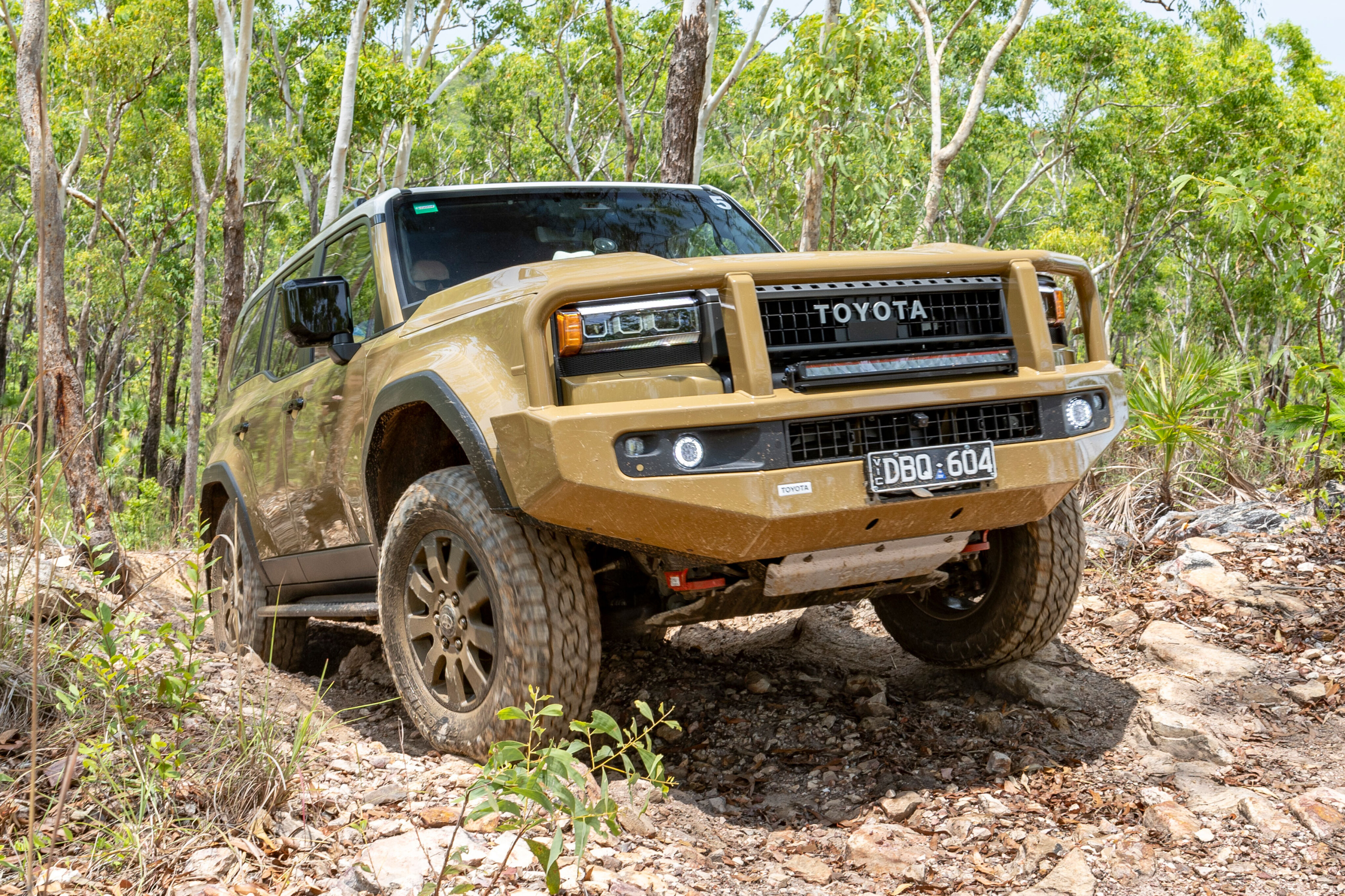
Things we like
- Good size
- Proven powertrain
- Excellent driveability
Not so much
- Poor packaging in cargo area
- TPMS not standard on all grades
- Having to access regular functions in the media screen and not with buttons
Toyota Australia has launched its 2025 Prado and fittingly, it did so in the Northern Territory in Kakadu National Park, a place that the top specification Prado wears on its badge.
The 250 Series Prado will be sold here in five grades starting from the GX, then the GXL, VX, Altitude, and top-of-the line Kakadu models.
The Altitude model is now a full time model rather than a limited edition and it is the most offroad focused of the new Prados. It is the only variant that comes with a locking rear differential and front sway bar disconnect mechanism to give it better traction at the rear axle and more wheel travel at the IFS. It also comes on 18-inch all terrain Toyo tyres and is only offered as a five-seater leaving more room in the back for cargo by ditching the third-row seat. Leaving the rear seat out also helps with payload.

All 250 Series Prado are powered by the 1GD-FTV 2.8-litre diesel four-cylinder engine, boosted with Toyota’s with 48-volt V-Active technology. The tech doesn’t increase engine outputs and the mill still makes the respectable 150kW/500Nm that we are familiar with from the previous Prado and current Land Cruiser 70 models, HiLux and Fortuner variants. The engine is backed by a new 8-speed automatic transmission and a full-time/dual-range 4-wheel drive system. The new Prado offers a 3500kg towing capacity with an integrated towbar that is prewired and ready to use.
The 250 Series Prado rides on a variant of the same TNG-F chassis that underpins the Land Cruiser 300 Series, the Lexus GX550 and the Toyota Tundra pick up. It’s a bigger car than the 120/150 Series Prado and more akin to an 80 Series Cruiser in size.
Styling-wise the boxy body takes many ques from the 60/62 Series Cruisers of yesteryear to give it a retro appearance with the Australian models all featuring the FJ62-like rectangular headlight while the round headlight as seen on the LC250 in some other markets will not be offered here on any grade.
The body is tall and spacious in a very traditional 4x4 wagon way.
Much of the height is in the upper part of the body giving a large glasshouse with an upright windscreen to give plenty of outside visibility for both the driver and passengers.

Inside, all models get the premium 12.3-inch multimedia screen that is compatible with wireless Apple CarPlay and Android Auto, Bluetooth connectivity, and cloud-based in-built sat-nav. The levels of trim vary with the model grades but all seem to be very well appointed and laid out. We were impressed with the dash layout and functionality in the LX550 when we tested it early this year and the Prado carries over much of that design albeit with a smaller screen and less leather.
With the multimedia controls, driving and terrain modes, HVAC and 4x4 functions, it becomes a very busy cockpit and one that will take some acclimatisation to be totally familiar with it and able to operate without taking your eyes off the road. But most controls are well positioned and easy to operate.

One annoying function was the parking distance sensors which when driving through the long grass of Territory scrub were beeping constantly. There’s no button to turn them off and to do so you need to scroll through the menus on the dash screen and find the setting where you are able to switch them off. A simple one press button that the driver could press without having to stop the car and scroll through menus would be a far more logical control for this function.
But the biggest complaint with the interior and probably the whole car, is in the cargo area at the back.
In both seven-seat/three row models and the five-seat two row variants, the floor of the cargo area has a plastic cover over it. in the five-seaters it sits around 10cm high and eats into the cargo volume. In the seven seat models it probably doubles that depth to match the height of the folded third row seats which themselves take up a lot of space as they can’t fold flat into the floor.
Only the Prado GX and Altitude models are available with five seats, the rest all come with seven seats.
Toyota tells us that the reason they can’t fold in to the floor or have a flat floor in the 5-seaters, is because under here is where the battery is mounted in the hybrid models in overseas markets, not the Australian Prado as the lithium battery for the 48-volt system in the 48-Volt V-Active system are much smaller.

In the Lexus version of this car, the GX550, the floor is flat with no such intrusion so I’d be very interested to see what’s under the plastic false floor in the five-seat Prado and what this means for installing storage drawer systems.
The cargo area does have four tie-down points in the corners to secure your cargo but the plastic covers are labelled with a 60kg load limit.
Speaking of load limits, the roof is rated to 90kg while towing is up from 3000kg to 3500kg with a 6600kg GCM which doesn’t leave a lot of meat in to reach the 3100 to 3200kg GVM (model dependant) if you haul a heavy trailer.
The Prado itself tips the scales at 2495kg (GX); 2535kg (GXL); 2570kg (VX); 2520kg (Altitude); 2595kg (Kakadu) and unlike the similar in size and built on the same platform, LC300, doesn’t use a lot of aluminium panels. A quick check with the magnet showed that only the bonnet on the Prado appears to be aluminium with the rest being steel.

ON THE ROAD
The drive from Darwin to Kakadu National Park gave us a range of roads and driving conditions to get a feel for the 250 Series Prado. Around town the driver appreciates the excellent visibility afforded by the large glasshouse and the comfortable seating position. For this leg we were in a GXL spec Prado and were impressed with the level of kit in what has traditionally being a popular family wagon. Heated and cooled faux leather seats add a more premium feel to the GXL over what it has offered in the past generations. This also gave us a better appreciation of the considerable price increases across the Prado range.
Toyota’s team of engineers has done a great job of isolating the cabin from NVH from the four-cylinder diesel engine road and wind noise.
There was a little bit of wind noise heard around the A-pillars but that was at the Territory’s higher than average speed limits. We also found the noise from the 18-inch tyres on this car to be quieter than that from the 20 inch tyres fitted to the VX Prado that we dove back to Darwin.
The 500Nm 2.8-liter engine provides plenty of power for highway driving including getting past road trains at highway speeds. The new 8-speed automatic transmission was quick to kick down and respond to a floored throttle and the engine pulls strongly.

Cruising at highway speeds is comfortable with the engine ticking along at just 2300rpm at the posted speed limit. Initial thoughts that the 1GR-FTV engine wouldn’t deliver the performance and refinement expected for the new Prado were soon forgotten. It’s no V6 like that in the petrol-fuelled GX550 or the diesel V6 in a Ford Everest but a worthy alternative that is up to the task.
Noteworthy is the Prado’s electric power steering which is the first we’ve seen for the name plate.
At low speeds it lightens up the steering effort required for ease of use and as speed rises it firms up for better control. It never felt too light or heavy at all, being just right for the varying conditions.
Similarly, the coil spring suspension was never soft and wallowing or hard and harsh over all the terrain and corrugations we put it over as we left the highway and hit the dusty tracks. The overall feel of the Prado’s suspension is that it is firmer than Prados have been in the past but retain the comfort they have also been known for.
On a tight and winding bush track that threw up everything from corrugations, to mud, dust and rocks, the suspension and steering were always predictable and easy to control. With the drive modes selected to suit the road surface, the electronic drivers’ aids didn’t interfere or inhibit driving.

OWNERSHIP
Toyota Australia offers five years of capped-price servicing for the 250 Series Prado at $390 per service for the first 10 services, over intervals of six months or 10,000km – whichever comes first. Warranty is five years with unlimited kilometres.
SUMMARY
The 250 Series Prado is a step up from the previous 150 Series model and justifies the considerable price increases across the model range. It’s a better equipped, more spacious and better driving vehicle than any of the four generations of Prado before it.
Prado has always lead its class in the 4x4 wagon market, only dropping its top spot in 2024 as the previous model was run out. It’s closest competitor in both size and price, the Ford Everest, got the title in ’34 but Toyota is confident of getting its crown back in 2025. With 17,000 orders for the 250 Series in the books and following our first drive of the new Prado, we think they could be confident there.

PRICING
| GX: | $72,500 |
|---|---|
| GXL: | $79,990 |
| VX: | $87,400 |
| Altitude: | $92,700 |
| Kakadu: | $99,990 |
| Premium paint: | $675 |
| Optional paint + two tone (Altitude only): | $1675 |
SPECIFICATIONS
| ENGINE | 4-cyl turbo diesel |
|---|---|
| CAPACITY | 2755cc |
| MAX POWER | 150kW@ 3000-3400rpm |
| MAX TORQUE | 500NM@ 1600-2800rpm |
| TRANSMISSION | 8-speed automatic |
| 4X4 SYSTEM | Full-time, dual range |
| CONSTRUCTION | 5-door wagon on a ladder frame chassis |
| FRONT SUSPENSION | Wishbone and coil IFS |
| REAR SUSPENSION | Multilink coil live axle |
| TYRES | 18 or 20 inch |
| WEIGHT | 2595kg – 25-95kg |
| GVM | 3100kg-3200kg |
| GCM | 6600kg |
| TOWING CAPACITY | 3500kg |
| SEATS | 5 or 7 |
| FUEL TANK | 110L – 17.4L Adblue |
| ADR FUEL CONSUPTION | 7.6L/100km |
| ON TEST FUEL CONSUPTION | N/a |
| APPROACH ANGLE | 31° (GX/GXL); 32° (VX/Altitude/Kakadu) |
| DEPARTURE ANGLE | 17° |
| GROUND CLEARANCE | 210mm (GX/GXL); 221mm (VX/Altitude/Kakadu) |
| WADING DEPTH | 700mm |

Things we like
- Good size
- Proven powertrain
- Excellent driveability
Not so much
- Poor packaging in cargo area
- TPMS not standard on all grades
- Having to access regular functions in the media screen and not with buttons



COMMENTS